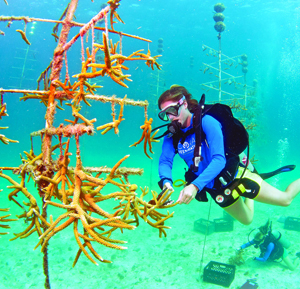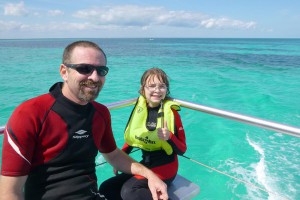One of nature’s greatest wonders is a living coral barrier reef, and the Florida Keys island chain is home to the only one in the continental United States. The teeming backbone of marine life, running the length of the Keys about 5 miles offshore, is so unique that divers and snorkelers who explore it will never forget the experience.

Along Islmorada’s reefs, high-profile coral heads and broad ledges shelter French grunts and goatfish, while regal queen angelfish casually graze amid recesses. (Photo by Tim Grollimund)
Keys coral formations are famous for their abundance of fish, from impressive schools of blue-striped grunts to toothy green moray eels. The U.S. government established the Florida Keys National Marine Sanctuary in 1990 to protect the essential ecosystem.
There is no more versatile marine destination in the world, which means preserving the Florida Keys reef is a top priority for a good reason.
Visitors to the island chain can join residents in playing a significant role as stewards of the reef ecosystem. Environmental enthusiasts interested in aiding in reef restoration in the Keys can join marine scientists with multiple coral restoration organizations to productively give back to the living, dynamic underwater ecosystem. Divers and nondivers alike can get actively involved.
Florida Keys coral restoration entities include Reef Renewal USA, the Coral Restoration Foundation, I.CAREand Mote Marine Laboratory’s Elizabeth Moore International Center for Coral Reef Research and Restoration.
Each organization is devoted to overcoming the challenges coral reefs face, developing ever-improving methods to propagate and maintain dozens of important coral species while preserving genetic diversity.
Volunteers at these organizations first learn about environmental impacts on Florida’s reefs in fun, casual-yet-educational workshops that reveal how experts are restoring endangered staghorn, elkhorn and boulder corals. All three are critical reef-building species that have the best chance to propagate and create new habitats within a year or two.

A Coral Restoration Foundation staffer works in CRF’s coral nursery. (Photo by Tim Grollimund, Florida Keys News Bureau)
Hands-on activities include “coral fragging,” fragmenting a brood stock of corals into smaller pieces for widespread propagation — then prepping the fragments to be placed on “coral trees” in offshore nurseries for continued growth and eventual outplanting to natural reef locations.
Scuba divers go on working dives to coral nurseries to clean and prepare corals for planting at a restoration site, enabling them to see firsthand the evolution of corals over time.
For many recreational divers, what starts as an interest evolves into a dedicated mission; they get passionately “hooked” on coral restoration, giving back to the oceans that are so essential to life.
Visit any of the organizations’ websites today to learn how to join a coral restoration workshop, or visit fla-keys.com/voluntourism.
In addition to embracing “voluntourism” activities, divers and snorkelers can become stewards of the coral reef by following the reef protection tips here during their Keys vacations.

Divers like Mike McWilliams and daughter Cori help preserve the Keys reefs by following eco-conscious practices. (Photo by Celeste McWilliams)
ONE: Verify weather conditions before going out on the water. Poor visibility, strong winds and wave action can create dangerous conditions at the reef.
TWO: Remember that even the lightest touch with hands, fins or other dive and snorkel equipment can damage sensitive coral polyps — the tiny living animals that create the hard and soft corals of the reef.
THREE: Avoid contact with the ocean bottom; properly weighted divers should practice proper buoyancy control. Sandy areas that appear barren may support new growth if left undisturbed.
FOUR: Snorkelers should wear buoyancy control or snorkel vests to allow gear adjustments without standing on the coral.
FIVE: Remember, it’s illegal to harvest coral in Florida.

People who dive or snorkel from their own boats should use reef mooring buoys instead of dropping an anchor.
SIX: Please don’t feed the fish; it destroys their natural feeding habits.
SEVEN: If you dive or snorkel from your own boat, use the reef mooring buoys instead of anchoring.
EIGHT: When booking a dive or snorkel excursion, look for a professional Blue Star operator. The Blue Star program was established by the Florida Keys National Marine Sanctuary to recognize operators who are committed to promoting responsible and sustainable diving and snorkeling practices. Blue Star operators take the extra step to educate you to be a better environmental steward and to interact responsibly with coral reefs in the Keys.
Throughout the island chain, there are opportunities to contribute in meaningful ways and witness the powerful impact eco-conscious people can make by taking action. To find out more, just click here.

